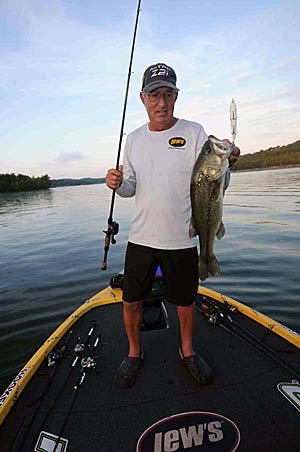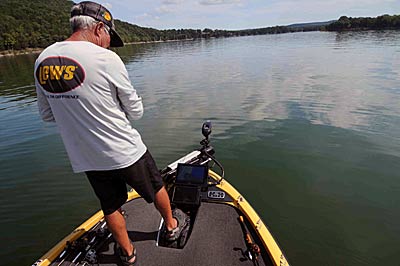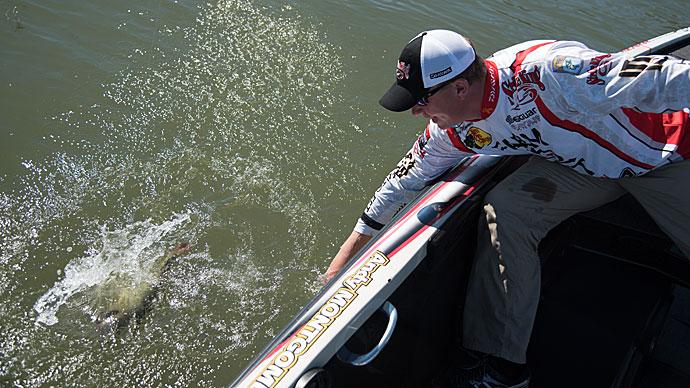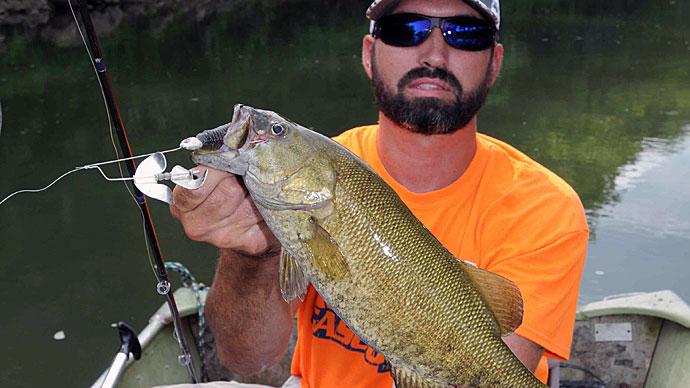
The weather is steamy, and the water is hot, but bass are starting to feel the urge to move from their summertime haunts.
The late summer/early fall period is a time of change for bass on clear highland reservoirs such as Missouri’s Table Rock Lake.
“Usually then the thermocline is breaking up, so the oxygen level is at no specific place in the lake,” Table Rock Lake guide Pete Wenners says. “Normally, in the summer, the bass are at 25 to 35 feet or whatever the thermocline is, but once that breaks up, a lot of those fish will go down even deeper, and some of them will go dead shallow. So it is one of those deals where you can catch them from 2 to 50 feet.”
Wenners suggests it’s hard to target both shallow and deep bass on the same day, so he keys on the bass’ forage to determine the depth he will fish each day. “Usually, if you can find the bait shallow, you are going to find some bass around them,” he says.
The veteran guide notices shad start migrating into the creeks in August, and it takes a few weeks for the bass to follow the forage. “If you get the shad and the bass back in those creeks, there are multiple ways to catch them depending on the creek,” Wenners says. Wenners finds bass in the middle of the creek holding tight to the cover in creeks with shallow flats filled with logs and stumps. Shad will be roaming around in the middle of the creek, and bass hiding in the stumps or logs will blast any baitfish that wander too close to the cover.
A Strike King KVD 1.5 Square Bill crankbait is Wenners’ choice for catching bass in extreme shallows of mud-bottom creeks. If he finds bass in deeper water in the backs of the creeks, Wenners switches to the KVD 2.5 Square Bill. He will make multiple casts at several angles to the same wood cover to trigger bites.
Another tactic he employs for bass in the creeks on sunny days is slowly walking a Strike King Sexy Dawg or Zara Spook topwater plug and stopping it over the top of the brush. “It’s like the fish can’t stand that lure over the top of its head,” Wenners says.
Late summer/early fall transition bass can also be caught early in the morning on River2Sea Whopper Ploppers and buzzbaits. On a recent trip with Wenners, I caught a 3-pound Kentucky bass on a Whopper Plopper in front of a dock and lost a 2-pound largemouth on the same lure in about 2 feet of water along a secondary point. Wenners caught a 4-pound largemouth on the Strike King Sexy Dawg along a secondary point.

Docks are also good holding spots for late summer/early fall bass. “The fish are always around certain docks,” Wenners says. The former Bassmaster Open competitor keys on docks in 30 to 60 feet and fishes the last two or three stalls at the end of the docks where bass suspend under the boat hoists. A 1/2- or 3/4-ounce white Slab Spoon is his first choice for tempting these fish.
“If I find the fish on my Garmin LiveScope and they are higher up in the water column or if I am getting bites on that heavy slab spoon in that 5 to 15-foot range, I will pick up a flutter spoon like a Dixie Jett or the (River2Sea) James Watson Worldwide Spoon,” Wenners says. The flutter spoon falls slower than the slab spoon and stays in the strike zone longer to trigger strikes from less aggressive bass.
“The good thing about spoon fishing is if there are a couple of guys in a boat, normally when you get those fish fired up under the docks, they are not alone,” Wenners says. “So as soon as one guy gets a fish on, the other guy needs to pitch right in there immediately because you usually have the group of fish fired up.”
Clear highland lakes are usually noted for catching bass in deeper water, so deep water patterns are still productive for late summer/early fall bass.
“The deep bite is usually pretty consistent once you have the fish located,” Wenners says. “The problem is the fish will be anywhere from 25 to 55 feet deep because the thermocline is gone.”
Finding the depth of the baitfish is the key to locating deep bass then.
Drop-shotting a finesse worm is one of Wenners' most effective ways to catch deep bass during late summer and early fall. His drop-shot rig consists of a Strike King KVD Dream Shot worm in a morning dawn color or a purple-brown laminate Chompers Drop Shot worm set above a 1/4-ounce lead weight.
Once he finds the baitfish with his Garmin Panoptix LiveScope, Wenners watches his drop-shot rig on his Garmin GPSMAP unit's screen to ensure it stays above the fish and the treetops of the standing timber. When his bait reaches the correct depth, he marks his line at the end of his rod tip with a marker pen that helps him keep his rig at the same depth.
The weather during the late summer/early fall transition often dictates whether Wenners fishes shallow or deep. On cloudy days he usually starts with a topwater lure or a buzzbait and follows up with a spoon when the fish move deeper. He also fishes topwaters early in the morning on sunny days before going deep. However, if he has been catching quality bass deep in previous days, Wenners will target those deep fish in the mornings.
The Missouri guide notices the action for bass holding on deep structure is more consistent during late summer and early fall. “Their depth might change, but those fish usually live in the same area,” Wenners says.
BassResource may receive a portion of revenues if you make a purchase using a link above.




